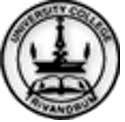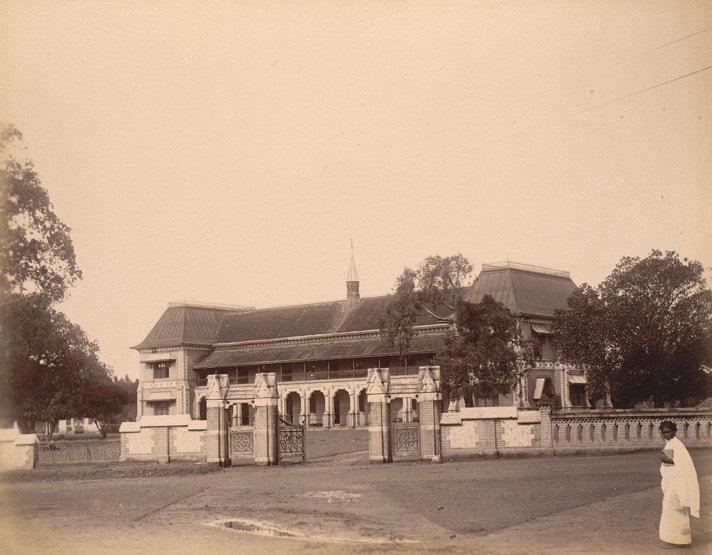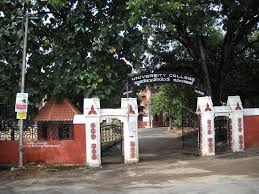
Last year, 2019, University College, Trivandrum, was in the news for all the wrong reasons. It brought back memories of my own association with the College over the years. I discuss below, my association with the College, a bit of history, and some alumni.
My association
In 1971, after we moved to Trivandrum, I used to go to my school passing through the University College, after having got off by bus at the VJT Hall.
Later, while doing my Pre-Degree (present +2) at Government Arts College, I used to visit the College to attend lectures organized by the Science Society, Trivandrum. My teachers included Dr. V. Parameswaran Nair, then an M.Sc. student. VPN, as we used to call him, had taught me earlier when I was in school, in 8th standard, and he himself was doing his Pre-Degree. He is now a theoretical physicist, and Distinguished Professor at the City College of New York. One of the others was Thanu Padmanabhan, then in his last year of B.Sc. Physics at the University College. He is also a theoretical physicist and Distinguished Professor, at the Inter-University Centre for Astronomy and Astrophysics, Pune. Attending the lectures in the hallowed gallery-type wooden-panelled classrooms of the Physics Block was one of the lasting memories of my student days.
Among the lectures was one by Dorothy Hodgkin, Nobel Laureate for Chemistry in 1964. She began her lecture with references to Mahatma Gandhi and C.V. Raman, whose were the only pictures in the class room, hung on both sides.
After my Pre-Degree, I was keen to study at University College, more for sentimental reasons. That was where my father, grandfather, and great-grandfather had studied. I gave a funny combination of three options, Economics, English Literature, and Physics, while applying. And was admitted to Economics. Narendra Prasad, the charismatic English lecturer at Arts College, who countersigned my application form, was quite amused seeing my three options. Narendra Prasad was also an acclaimed theatre actor and would later become a household name after making a late foray into Malayalam movies, creating a niche for himself as a villain in many films.
The University College was named after the University College, London. It always boasted of outstanding teachers and students. A.R. Raja Raja Varma, the Malayalam grammarian, was both a teacher and one of the first Indian Principals. Until a few years before I joined, it had Professors with PhDs, mostly from London. Its Chemistry, Mathematics, History, English and Economics Departments were particularly well known. At least until 1960s, or maybe till it was taken over by the Government in 1957, the best students used to get automatically recruited as faculty. Thus, S. Venkitaramanan, who joined the IAS and later became Finance Secretary and Governor, Reserve Bank of India, was a “demonstrator” in the Physics Department, where he was a topper in the B.Sc. Examination. My father also taught history at the College from 1952 to 1957, after having completed B.A. Honours and teaching for a year at Pandalam. In 1957, he also joined government service. So, did the two other toppers from his class, one of them (G.R. Nair) becoming a Chief Secretary in Andhra Pradesh. The other one, P.S. Habeeb Mohammed went to the Odisha cadre only to come back as a Vice Chancellor of the University.
The College was strategically situated in the middle of three libraries that I was found of. In order of preference, the first was the British Library, located in an old bungalow, with spacious bright and airy interiors with extremely friendly staff, right behind the Secretariat. Second was University Library on the way to the University Office, and third the nearly 200 years old Public Library, all within walking distance. And then there was the Indian Coffee House about 100 metres away, in a heritage bungalow, now demolished, serving excellent cutlets and masala dosa, with beet root filling, which we affectionately ordered as MD.
After about two months of studying at University College, the romance and fling with nostalgia started wearing off, after I found out that if I had continued at the Government Arts College, which was also offering B.A. (Economics), apart from B.Com., I could have opted for Mathematics as a subsidiary instead of History that University College was offering. Moreover, one of the optional papers was Banking Systems while the one in University College was something that did not interest me.
Shifting back to the Arts College was not easy. It involved collecting an application form from the University Office, getting a No-Objection from both University College and Arts College, presenting it again to a particular Section in University Office, wait for the approval, and take it back to the respective colleges. It too me several to-ing and fro-ing, sitting with the University clerk, helping him draft his note, and about two to three months before I was back at the Government Arts College.
History
The University College has a long story behind it. In 1934, Swati Tirunal Rama Varma, then ruler of Travancore, and a celebrated musician and composer, visited a private school in Nagercoil, now in present day Tamil Nadu. The school was imparting education in English medium. Then barely 21 years old, Swati Tirunal wanted a similar institution in Trivandrum. Mr. J. Roberts, who was running the Nagarcoil school was invited to set up a school for a grant of Rs. 100. About a year later, the school was taken over by the government and came to be known as ‘The Raja’s Free School’. It was located in the area where the present Ayurveda College stands. The following year, it was shifted to a new building where the University College stands now. The school continued to be free till 1864.

The school was raised to the status of a College, which started functioning from the same premises in 1866. It was named H.H. The Maharaja’s College, and was attached to the Madras University. The original two-storeyed structure which is at the core of the present College was built in 1870. Mr. John Ross was the first Principal. Other eminent Principals included A.R. Raja Raja Varma, poet and Malayalam grammarian. The school which had continued to function at the same premises was shifted to Vanchiyoor in 1919.
The College was bifurcated in 1924 into H.H. The Maharaja’s College of Science and H.H. The Maharaja’s College of Arts, the latter in a new three-storeyed premises in Thycaud. The two Colleges were reaffiliated to the Travancore University which was started in 1937, and were reunited in 1942 to become the University College. Again, after independence, the Intermediate (later Pre-Degree and now +2) section was segregated in the Thycaud College, which came to be known as Intermediate College, later becoming the Arts College, by which name it is known even now. The University College became a post-Intermediate institution.
Alumni
The alumni of the College include several eminent persons including scientists, civil servants, businessmen, writers, film personalities, and politicians. Based on the internet and other sources, some of the eminent alumni include the following: Raja Ravi Varma, painter, A.R. Raja Raja Varma, poet and Malayalam grammarian, C.V. Raman Pillai, Malayalam novelist, Anna Chandy, first woman judge in India, K.R Narayanan, former President, “Shankar” K.S. Pillai and Abu Abraham, cartoonists, S. Boothalingam, former Finance Secretary, and his son-in-law, M.S. Swaminathan, the agricultural scientist, P.C. Alexander, civil servant, S. Venkitaramanan, former Finance Secretary, and Governor, Reserve Bank of India, P.K. Iyengar, nuclear physicist, G Madhavan Nair, former Director, ISRO, S. Guptan Nair, K. Ayyappa Panicker, O.N.V. Kurup, and K. Sugathakumari, writers, Fathima Beevi, first woman judge of Supreme Court, J.C. Daniel, father of Malayalam Cinema, Kris Gopalakrishnan, co-founder of Infosys, Priyadarshan, film director, R. Sankar, former Chief Minister, V. Parameswaran Nair and Thanu Padmanabhan, theoretical physicists mentioned earlier, and Arun Kumar, Assistant Secretary with the Obama Administration in the US and now head of KPMG India.

Where it stands
In the early 1990s, thanks to constant student activism, which used to take out processions to the nearby secretariat, the government had decided to shift the undergraduate courses to faraway Kariavattom, and make the University College a post-graduate and research institution. But, this was dropped a few years later. Student activism has increased several fold climaxing in a stabbing incident in 2019. Some of the faculty who had taught there inform me that it is difficult to carry out normal education activities there and that student union leaders stop classes for even flimsy reasons. I understand the College has for long not been one of the prime choices of good students.
![]()